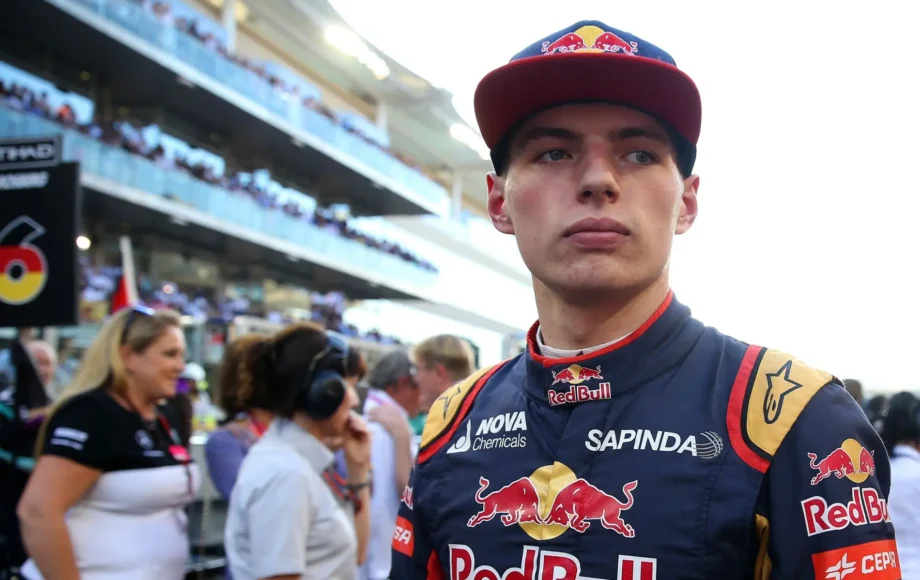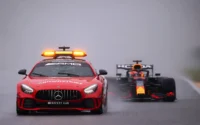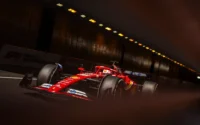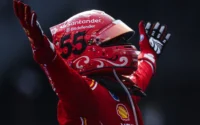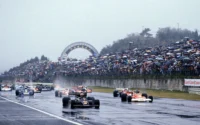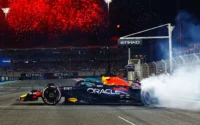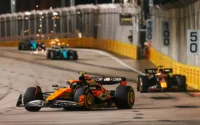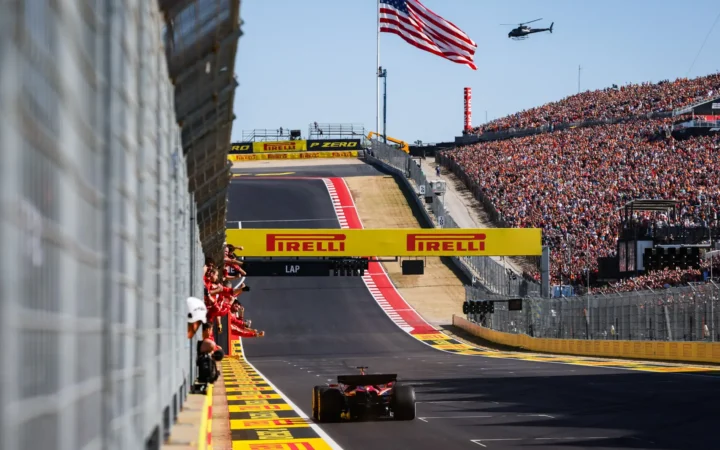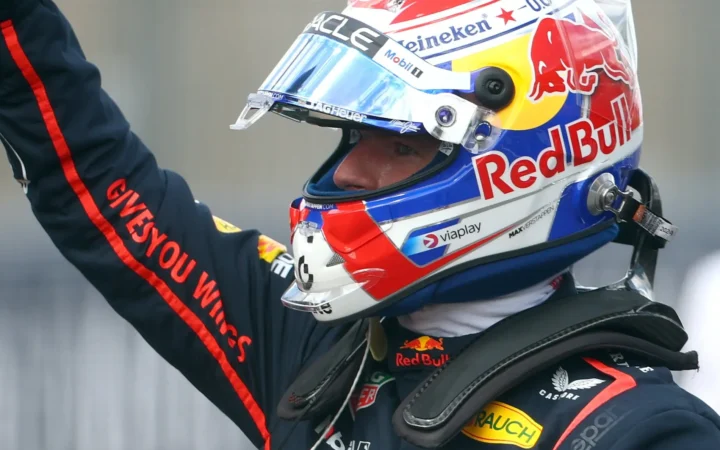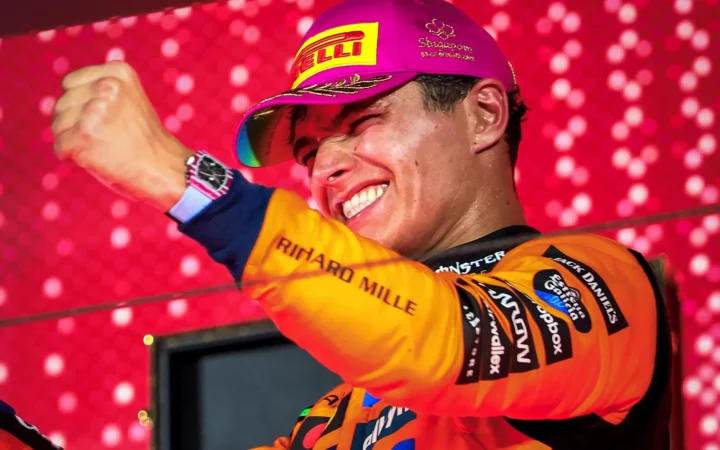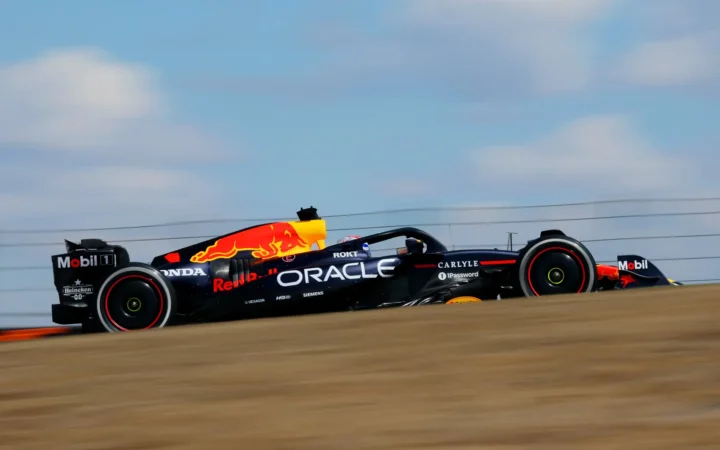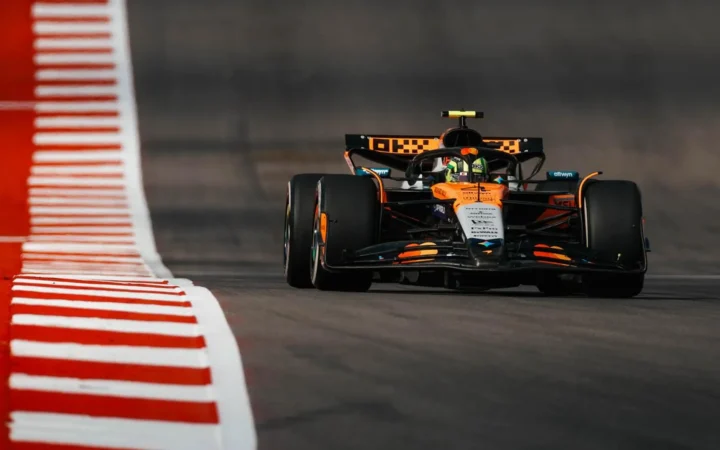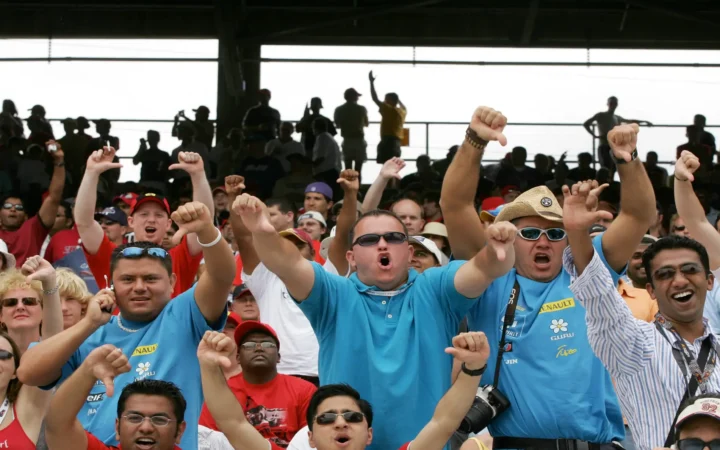Formula 1 boasts incredible records and facts backed by numbers and stats where speed equals more. Alongside those are some of the most unbelievable facts in F1 history that will amaze even the most seasoned fans. Imagine the irony of Juan Manuel Fangio, a legendary five-time world champion, nearly losing his driver’s licence off the track. Or consider the contradiction of Max Verstappen, who steered his way into F1 history as the youngest-ever driver at just 17, all before he was legally allowed to drive on public roads. And let’s not overlook Sebastian Vettel, whose 2005 debut in F1 and again with Aston Martin in 2021 saw him issued penalty points within mere seconds of starting.
What to know
- Juan Manuel Fangio nearly lost his driver’s licence despite being a five-time world champion.
- Max Verstappen become the youngest-ever F1 driver, but without a driver’s licence.
- Sebastian Vettel racked up penalty points after six-seconds on his F1 debut in 2005, and again on his Aston Martin debut in 2021.
These facts and records are just the tip of the iceberg. In this article, join us as we explore more of these incredible tales from the pinnacle of motorsports that dates back to the first-ever race in 1950, a championship that started on May 13 at Silverstone and ran until September 3 at Monza. One that paved the way for decades of incredible Formula 1 history.
Every ‘Hill’ has been a World Champion
There have been three F1 drivers with the surname Hill: Phil Hill, Graham Hill, and Damon Hill.
Phil Hill won the Championship with Ferrari in 1961, and he was also the first American to win the F1 World Drivers’ Championship.
Graham Hill was a two-time world champion in 1962 and 1968, and Damon Hill, who is also Graham Hill’s son, won the title in 1996. Graham Hill is also the only driver to have completed the Triple Crown by either its World Drivers’ Championship or Monaco Grand Prix definition. Events that make up the traditional (Indy 500 / Le Mans 24 Hours, Monaco GP) and the alternative (Indy 500 / Le Mans 24 Hours, F1 WDC). He won Monaco an incredible five times.
| Indy 500 | Le Mans 24 Hours | Monaco GP | F1 WDC |
|---|---|---|---|
| 1966 | 1972 | 1963 1964 1965 1968 1969 | 1962 1968 |
Damon Hill, the son of Graham Hill, became the first son of a World Champion to also win the F1 title, accomplishing this in 1996 with Williams.
Most overtakes in a single lap
As of 12 January 2025, during the third lap of the 2023 Dutch Grand Prix, a record-breaking 63 overtakes were made, beating the previous record of 45 overtakes in a single lap. This Grand Prix also featured a high number of overtakes, with 186 passes made on the track, a substantial gain from the 23 overtakes recorded the previous year at Zandvoort.
The record for the fewest overtakes in a Formula One race is zero, a mark reached in several races: the 2003 Monaco Grand Prix, the 2005 United States Grand Prix, the 2009 European Grand Prix, the 2021 Monaco Grand Prix and the 2021 Belgian Grand Prix.
Juan Manuel Fangio lost the use of his driver’s licence
After Juan Manuel Fangio was inducted into the International Motorsports Hall of Fame in 1990, he led a much quieter public life, but he came back into the spotlight in 1994 when he opposed a new law in the Province of Buenos Aires that denied issuing driving licenses to individuals over 80, a regulation that affected him directly. When his license renewal was denied, Fangio was rumoured to have challenged Traffic Bureau staff to a race from Buenos Aires to the coastal city of Mar del Plata—a distance of 400 km (250 miles)—in under two hours. His bold challenge led to an exemption being granted to the five-time World Champion who gained his driver’s licence back.
Max Verstappen drives in F1 before a driver’s licence
Max Verstappen, who made his Formula 1 debut at just 17 years and 166 days old during the 2015 Australian Grand Prix. He became the youngest F1 driver ever to compete in Formula 1 before he even had his road driver’s licence. He was able to race with an F1 Super Licence, a special licence issued by the FIA based on points earned through points scored in various racing series.
Verstappen passed his road driving test on his first attempt several months into his F1 career, though he humorously noted that the examiner was less than pleased, acknowledging how embarrassing it would have been to fail him. Verstappen’s first major test came in 2013 when he drove 160 laps in a Formula Renault car at the Pembrey Circuit and later tested a Formula 3 car in December of that year.
Following 2021, the FIA amended its rules, requiring drivers to be over 18 and possess a road license before receiving a super license to race in Formula 1.
Formula One History Recommends
Sebastian Vettel is issued points on his debut
Sebastian Vettel‘s entry into Formula 1 was as dramatic as it was swift. During the 2006 Turkish Grand Prix, at just 19 years old, Vettel experienced his first-ever Formula 1 weekend, serving as BMW Sauber‘s third driver in Friday’s practice session. No sooner had he driven out of the garage for the first time, Vettel sped through the pit lane, resulting in an immediate penalty. The penalty came just six seconds into his Formula 1 career, setting an unusual record for the quickest penalty in a debut. Despite this initial hiccup, Vettel’s performance during the practice session was impressive, showcasing his potential and setting the stage for a successful career. He secured four back-to-back titles with Red Bull between 2010 and 2013.
Later into his career, Vettel’s debut with Aston Martin at the 2021 Bahrain Grand Prix was marked by challenges with the car, including accumulating five penalty points on his super licence due to two incidents over the race weekend.
During the race’s later stages, Vettel collided with Esteban Ocon in an Alpine at Turn 1, which resulted in both drivers temporarily stopping but eventually restarting their cars. Despite Vettel’s claims that Ocon had altered his line while braking, the stewards awarded him a 10-second time penalty and two penalty points, concluding that Vettel was entirely at fault for the incident, as evidenced by video and telemetry data.
In addition to the race incident, Vettel faced setbacks even before the main race. He received a grid penalty and three penalty points during Saturday’s qualifying for not reducing speed under yellow flags. This penalty lowered his 18th-place qualifying position, relegating him to start at the back of the grid.
In 1997, Michael Schumacher and Jacques Villeneuve never shared a podium
In 1997, the Formula 1 season unfolded with an intriguing subplot involving Michael Schumacher and Jacques Villeneuve, two of the sport’s leading drivers’ at the time. Despite competing in all 17 races of the season, they remarkably never shared the podium in any single event. Their paths on the track seldom crossed directly, which added an element of surprise to the championship’s climax. The title contention between the two reached a dramatic and controversial peak during the final race of the season at the 1997 European Grand Prix in Jerez. In a decisive moment, Schumacher and Villeneuve collided, a clash that ultimately led to Schumacher’s disqualification from the championship standings and Villeneuve securing the title. A stark contrast to the season’s pattern, where direct confrontations between the two were scarce, making the collision a pivotal and unexpected twist in the championship narrative.
Hans Heyer becomes the only driver in one race to receive a DNQ, DNF, and DSQ
Hans Heyer etched his name in Formula 1 history for a rather unconventional reason: he is the only driver to have ever recorded a DNQ, DNF, and DSQ in the same race. For those unfamiliar with F1 jargon, here’s a quick breakdown
- DNQ (Did Not Qualify) indicates a driver failed to secure a qualifying time or was too slow to make the race lineup.
- DNF (Did Not Finish) means the driver started the race but could not complete it.
- DSQ (Disqualified) speaks for itself.
These terms usually represent separate, standalone outcomes, but Heyer remarkably achieved all three at the 1977 German Grand Prix at Hockenheim. The event had limited grid slots, allowing only 24 of the 30 entrants to race, which Heyer initially failed to secure, thus earning his DNQ. He wasn’t expected to race as a third reserve, but due to unforeseen withdrawals and a starting light malfunction, he slipped onto the track unnoticed. His race ended abruptly after nine laps due to gearbox failure, marking a DNF. His unauthorised start also led to a disqualification. This series of misfortunes culminated in a de facto lifetime ban from Formula One, as it was his first and last appearance in the sport.
Despite this infamous F1 outing, Heyer had some success in touring car races. However, his 14 attempts at the 24 Hours of Le Mans ended ironically in DNFs.
Jenson Button was the first driver to press the DRS button
Jenson Button is the first Formula 1 driver to press the DRS (Drag Reduction System) button in a race at the 2011 Australian Grand Prix, a revolutionary addition to the sport introduced in 2011. The DRS system was designed to aid in overtaking by reducing aerodynamic drag, thereby increasing the trailing car’s speed relative to the car ahead when activated.
Button was also featured in its first broadcast, which showed a successful overtake of the system during the 2011 Australian Grand Prix. Fernando Alonso became the first driver to use it in a successful overtake during the same race, but the move was not aired.
Kimi Raikkonen paid €16 Million not to race
In 2010, Kimi Räikkönen found himself in a unique position when Ferrari terminated his contract a year early to make way for Fernando Alonso. As a result, Räikkönen was paid a substantial sum of €16 million to not race in F1 that year. Interestingly, this payout made Raikkonen one of the highest earners in the sport, topping Felipe Massa, who was actively driving for the team. Only Alonso, who had replaced him at Ferrari, earned more than Raikkonen that year. Later, when Kimi returned to the paddock with the Lotus F1 Team, his success almost bankrupted the team after scoring too many points.
105 grid place penalties for the McLaren team in 2015
At the 2015 Belgian Grand Prix, McLaren drivers Fernando Alonso and Jenson Button faced an unprecedented number of penalties, totalling a staggering and record-breaking 105 grid positions. This extreme number was imposed on the drivers due to numerous changes made to their Honda engines, which far exceeded the allowable changes under the existing regulations.
Only six cars start the US Grand Prix
The 2005 United States Grand Prix, held on 19 June at the Indianapolis Motor Speedway, is infamous in Formula One history, with only six cars starting the race due to a series of unfortunate events. During practice, Toyota driver Ralf Schumacher crashed, caused by a tyre failure, and highlighted that Michelin’s tyres could not handle the high speeds on the track’s banked section. Despite this, the FIA refused to alter the track layout, and no consensus could be reached among the ten teams on how to proceed.
As a result, the 14 cars equipped with Michelin tyres withdrew to the pit lane before the race started. The action sparked outrage among fans, who booed and hurled beer and rubbish onto the circuit. The FIA subsequently blamed the teams for not having the appropriate equipment for the race conditions. The fallout from this debacle was so severe that the event’s reputation suffered irreparably, leading to its cancellation two years later.
Lewis Hamilton scored the most points in an F1 race – 50
In the 2014 Formula One season finale in Abu Dhabi, a unique scoring system was implemented, and points were doubled to maintain the championship’s suspense until the very last race. Lewis Hamilton secured 50 points for his win, a significant tally under this one-time scoring rule. Despite Hamilton’s impressive win for Mercedes, the Williams team amassed the highest total at the event, scoring 66 points. It was the only race in F1 history with double points.
Other F1 Facts and Records
Markus Winkelhock’s Incredible F1 Debut: From Last to First in a Single Lap
Markus Winkelhock made his Formula 1 debut with Spyker in the 2007 European Grand Prix at the Nürburgring. Although it was his only ever F1 race, he made headlines by leading the race for several laps under dramatic circumstances. Starting from the pit lane on wet tyres while others were on dry, he quickly took advantage of a sudden downpour to take P1 at the front of the field, leading against all odds before eventually retiring due to mechanical issue
Schumacher wins on Button’s debut, and Button wins on Schumacher’s farewell
In a remarkable piece of F1 symmetry, Michael Schumacher claimed victory at the 2000 Australian Grand Prix — the debut race of a young Jenson Button for Williams. Fast forward 12 years to the 2012 Brazilian Grand Prix, Schumacher’s final race before retirement (his second from F1), and it was Button who took the win, poetically bookending the legendary German’s career.
Who is number 0 in F1? A rare race number
In Formula 1 history, car numbers have often carried deep symbolism and tradition — but one number has remained largely unused: zero. Jody Scheckter is one of only two drivers ever to compete in F1 with the number zero on his car. Driving the McLaren M23, he raced with the number during the 1973 Canadian Grand Prix and the 1973 United States Grand Prix.
More than two decades later, Damon Hill — the 1996 World Champion — also raced with the number zero in 1993 and 1994, stepping in for reigning champion Nigel Mansell, who had left F1 for IndyCar. Since Mansell’s title was not being defended by a returning driver, Hill’s car carried zero instead of the traditional number one.
The most number of F1 pit stops by a Grand Prix winner
In a sport where two or three pit stops are considered the norm, winning a Formula 1 race after six trips to the pits is a rare and remarkable feat. Yet both Jenson Button and Max Verstappen managed to do exactly that — separated by over a decade.
Button’s win came at the 2011 Canadian Grand Prix, a race remembered as one of the most dramatic in F1 history. With changing weather, multiple safety cars, and a late pass on Sebastian Vettel, Button’s six-stop strategy paid off in a stunning last-lap victory.
Fast forward to the 2023 Dutch Grand Prix, and Max Verstappen found himself navigating similar unpredictability. On a soaked Zandvoort track with constant rain interruptions, Verstappen and Red Bull executed six well-timed pit stops en route to another dominant — yet hard-fought — win on home soil.
Fastest Lap through the Pit Lane at Donington 1993
The 1993 European Grand Prix at Donington Park is often remembered as one of Ayrton Senna’s greatest drives, and among its many iconic moments is a detail that still amazes F1 fans: Senna set the fastest lap of the race not on the track, but by driving through the pit lane.
On lap 57, with changing weather conditions and a strategic gamble in play, Senna bypassed slower traffic by taking an unconventional route — darting through the pit lane without stopping. The result? A blistering lap time of 1:18.488, the fastest of the race.
F1’s closest finish: 1971 Italian Grand Prix decided by just 0.01 seconds
Formula 1 has seen countless dramatic finishes, but none closer — or more chaotic — than the 1971 Italian Grand Prix at Monza. In a display of pure slipstream racing, five drivers crossed the finish line within just 0.61 seconds, the closest finish in F1 history.
Peter Gethin claimed the win in his BRM, edging out Ronnie Peterson by an almost impossible 0.01 seconds — a gap barely visible to the naked eye. Right behind them, Francois Cevert finished just 0.09 seconds back, followed by Mike Hailwood at 0.18 and Howden Ganley at 0.61 seconds behind the leader.
The race featured over 25 lead changes and a constant battle at the front, with Gethin’s win his only Grand Prix victory.
The shortest F1 career ever at just 800 metres
Formula 1 is known for its legends, records, and dramatic debuts — but few careers were as brief as that of Marco Apicella, who holds the unenviable record for the shortest Formula 1 career in history: just 800 metres (2,600 feet).
Apicella’s moment in the spotlight came at the 1993 Italian Grand Prix at Monza. The talented Italian had impressed team boss Eddie Jordan, who rewarded him with a one-off seat for his home race. But just seconds after the lights went out, Apicella’s F1 dream came crashing down — literally.
Caught up in a multi-car collision at the first corner of the first lap, Apicella’s car was damaged beyond repair, forcing an immediate retirement before he could even complete a single lap. He was never given another shot in Formula 1, making his career the shortest in terms of time and distance.
The shortest F1 race
The 2021 Belgian Grand Prix was the only F1 World Championship race ever to be completed without any racing laps under full green flag conditions. The race was red-flagged after only two laps due to heavy rain and poor visibility, and was never restarted. The race was the shortest in Formula One history. Originally planned to run for 44 laps, it ended during the third lap due to extreme wet weather conditions.
Full Race Report
Leclerc makes history in F1’s most processional race
The 2024 Monaco Grand Prix was the first time in a World Championship race that the top 10 drivers finished in precisely the same positions they started, making it the most processional race in F1 history.
Despite the lack of overtaking, it was a moment of emotional triumph for Charles Leclerc, who became the first Monégasque driver to win his home Grand Prix in the World Championship era — and the first since Louis Chiron in 1931, long before modern F1 began in 1950.
It was also Leclerc’s first win since the 2022 Austrian Grand Prix.
Full Race Report
What is the fastest F1 race? Monza 2025
No Formula 1 race has ever been quicker than the 2025 Italian Grand Prix at Monza — a track known as the “Temple of Speed.” Max Verstappen delivered a masterclass in speed that day, winning the race with a blistering average speed of 250.706 km/h or 155.791 mph.
Verstappen completed the 53-lap race in just 1:13:24.325, making it the fastest Grand Prix in F1 history in terms of total race time.
The previous record was set here by Michael Schumacher for Ferrari in 2003 (1:14:19.838, 247.585 km/h, 153.842 mph).
Full Race Weekend Report
F1’s Closest-Ever Qualifying: Three Drivers Set Identical Lap Times at Jerez 1997
The 1997 European Grand Prix at Jerez was already set up to be a classic — the title showdown between Michael Schumacher and Jacques Villeneuve had all the drama fans could hope for. But what happened in qualifying made F1 history: three drivers set the exact same lap time, down to the thousandth of a second.
Villeneuve was first to post a lap of 1:21.072, securing what would turn out to be pole position. Not long after, Schumacher matched that time exactly. Then, in a stunning twist, Heinz-Harald Frentzen, Villeneuve’s teammate at Williams, also clocked 1:21.072.
Three drivers, three identical times — something that had never happened before and hasn’t happened since. Because times were only measured to the nearest thousandth of a second at the time, the starting order was decided by who set the time first: Villeneuve on pole, Schumacher second, and Frentzen third.
This surreal moment was just the prelude to one of F1’s most controversial and unforgettable title deciders.
Youngest F1 race winner: Max Verstappen
Before he became a world champion, Max Verstappen had already etched his name into the Formula 1 record books. His meteoric rise began in 2014 when he joined Red Bull’s junior program and made his first appearance in an F1 race weekend at just 17 years and three days old, driving in a free practice session for Toro Rosso. That appearance made him the youngest driver in F1 history to take part in a Grand Prix weekend.
After a full debut season in 2015 — where he also became the youngest driver to score points — Verstappen’s talent quickly earned him a promotion to Red Bull Racing early in 2016. It didn’t take long for him to deliver: at the 2016 Spanish Grand Prix, in his first race for Red Bull, Verstappen held off a charging Kimi Räikkönen to take a sensational victory.
At 18 years and 227 days old, Verstappen shattered the record for the youngest Grand Prix winner, previously held by Sebastian Vettel.
Valtteri Bottas Sets F1 Top Speed Record at 372.5kph in Mexico
Valtteri Bottas’s blistering top speed at the 2016 Mexican Grand Prix still stands as a benchmark in the sport today.
Driving for Williams, Bottas clocked an official top speed of 372.5 km/h (231.4 mph) — the fastest ever recorded during an F1 Grand Prix. In fact, some FIA data even suggested he momentarily hit 373.3 km/h, although that number was never formally recognised. Regardless, Bottas became the first driver in F1 history to break the 370 km/h barrier in a race setting.
This record-breaking moment was made possible by a combination of factors: the ultra-low-drag setup of the Williams FW38, the long straight at Mexico City’s Autódromo Hermanos Rodríguez, and the high-altitude conditions, which reduce air resistance and allow for higher speeds.
Who are F1’s Youngest and Oldest Drivers?
Modern Formula 1 is often thought of as a young driver’s game, well apart from Fernando Alonso and Lewis Hamilton, both in their 40s come the 2025 season. But its history spans generations — quite literally. The youngest and oldest drivers to start a Grand Prix are separated by nearly four decades.
At one end of the spectrum is Max Verstappen, who became the youngest driver in Formula 1 history when he lined up on the grid at the 2015 Australian Grand Prix at just 17 years and 166 days old. Racing for Scuderia Toro Rosso, Verstappen shattered the previous record set by Jaime Alguersuari, beating it by almost two full years. His debut sparked changes in super licence rules, and his rise was so rapid that it redefined how young talent is evaluated in F1.
On the opposite end stands Louis Chiron, a name that connects F1’s modern era to its pre-war roots. A national hero in Monaco, Chiron competed in the 1958 Monaco Grand Prix practice session at 55 years and 292 days, making him the oldest driver ever to participate in a World Championship event. Though he didn’t start the race, his entry to practice alone set a record that remains untouched decades later.
F1 driver with the most Grand Prix starts
As of April 12, 2025, Fernando Alonso holds the record for the most Formula 1 race starts in history, with 404 Grand Prix starts from 408 race entries. The two-time world champion topped Kimi Räikkönen’s previous record of 349 starts during the 2022 season and has continued to add to his tally with Aston Martin.
Alonso reached his 400th Grand Prix milestone at the 2024 Mexico City Grand Prix, becoming the first driver in F1 history to achieve this feat.
Throughout his illustrious career, Alonso has amassed 32 victories, 106 podium finishes, and 22 pole positions, competing for teams such as Minardi, Renault, McLaren, Ferrari, Alpine, and Aston Martin.
Full Race Report
Fastest Pit Stop in F1 History
At the 2023 Qatar Grand Prix, McLaren shattered the stopwatch by executing the fastest pit stop in F1 history, changing all four tyres on Lando Norris’s car in a lightning-quick 1.80 seconds.
This incredible performance edged out the previous record of 1.82 seconds, set by Red Bull Racing during the 2019 Brazilian Grand Prix with Max Verstappen.
For a complete list of F1 Drivers’ and Constructors’ records visit our F1 Records section of the site.
Seen in:

